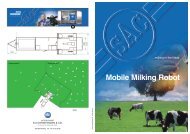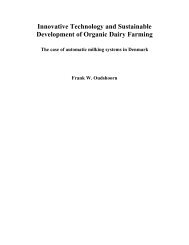Validation of Calibration Equations Developed ... - Automatic Milking
Validation of Calibration Equations Developed ... - Automatic Milking
Validation of Calibration Equations Developed ... - Automatic Milking
Create successful ePaper yourself
Turn your PDF publications into a flip-book with our unique Google optimized e-Paper software.
was determined with low uncertainty. In spite <strong>of</strong> these results the prediction intervals <strong>of</strong> the<br />
equations, and example predictions made with the equations, indicated that there could be<br />
great uncertainty about the future predictions (Hansson 2011). The aim <strong>of</strong> this report is to<br />
validate the calibration equations developed in the master thesis by Hansson (2011). In<br />
relation to the aim the following question is addressed: How precise are the predictions<br />
made by the calibration equations found in the Master’s thesis by Hansson (2011)<br />
Precision is in this report used to describe how close the predicted yield is to the actual yield<br />
and is expressed through: 1) the mean distance between predicted and actual yield in the<br />
statistical data analysis and 2) the percentage <strong>of</strong> predictions that are within ±10% <strong>of</strong> the<br />
actual yield.<br />
2 Materials and methods<br />
The data used for validation <strong>of</strong> the calibration equations were collected in a field trial at the<br />
research facilities <strong>of</strong> the Faculty <strong>of</strong> Agricultural Sciences at Aarhus University, Denmark. The<br />
trial was conducted in 2009 as a part <strong>of</strong> the grazing project “Grazing – also a part <strong>of</strong> the<br />
future cattle production 1 ”. The data was used by Hansson (2011) but not in the development<br />
<strong>of</strong> the calibration equations.<br />
2.1 Equipment<br />
The herbage samples cuts, made to determine the pasture yield in kilo dry matter per<br />
hectare (kg DM/ha), was cut with either a Haldrup harvester or a modified sheep shearing<br />
machine. The Haldrup harvester is a green mass harvester for experimental use, with a<br />
cutting width <strong>of</strong> 150cm. The height samples in millimetres (mm) were made with a CPM<br />
which measures height by infrared light. The tunnel shaped machine has rails with 18<br />
sensors mounted on the inside. The sensors are placed 20mm apart staring from ground<br />
level and send/receive infrared light; as a light beam is obstructed is additional height<br />
registered. For more detailed information see manufacturer’s webpage: http://www.cdax.co.nz.<br />
1 Danish title on the project: Afgræsning – også en del af fremtidens kvægbrug<br />
5




